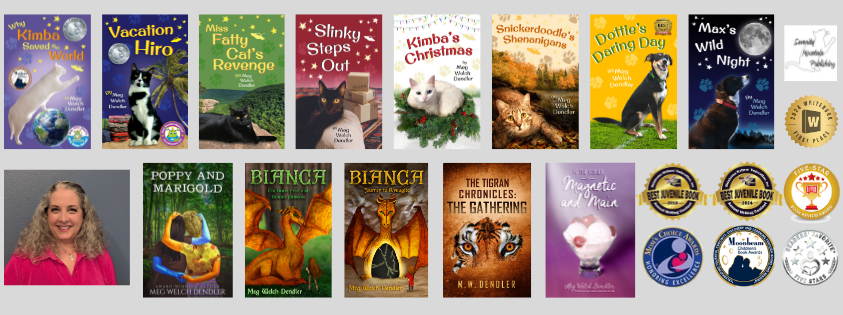Week 3: Set Your Goals And Expectations
So now you have honed your writing skills (week 1) and written a fantastic book (week 2). Here’s where you need to decide what your long-term goals and expectations are for this masterpiece. We did that at the start, but instead of goals they were really more like hopes and dreams. We hadn’t taken the time to do research and determine what we could realistically expect. Most of the stories writers hear are the “lightning in a bottle” ones. If your goal is to be that writer, you will end up highly disappointed 99.9% of the time.
You need to be clear about what you are doing, why you are doing it, and what you hope will come out of it. This is where the creative hat needs to be set aside and you need to become a publisher—assuming you want to make any money. A business person. I have run my own business before, so I had some experience with this. My husband has been a CFO, so he rules with a loving-but-practical fist from the office across the hall from me. We weren’t just publishing a book or a series of books. We were creating a business, and it needs to end up being profitable at some point. Otherwise, I can just write articles for magazines.
So, in this new business of self-publishing, what are your goals?
Traditional publishing is still an attainable goal. Maybe you want to exhaust that option first. But it isn’t what it used to be. If you think you really want to go that route come hell or high water so you can have a book tour and tons of money and publicity pouring into the promotion of your book, think again. Obviously, publishers have a vested interest in promoting and supporting every book they produce, but, unlike in decades past, they are going to expect most of that work to come from the author. Publishing staffs are limited. Funds are limited. Only the top few books that come out of that publishing house that year will get most of that staff and financial support.
This is why it is increasingly hard to get the attention of a traditional publishing house. They only want bonafide, sure-thing success. I did attempt that route for a bit with “Why Kimba Saved The World,” but I don’t have an agent to fight for me (and I’m not sure that would have helped). I don’t have proven main-stream success. My book is different and has personal pictures in a science fiction story. What’s a traditional publisher to do with that? The odds were highly stacked against me.
Self-publishing is a fantastic way to go, but you need to be clear about what you expect from the experience. What kind of book have you written? Does it have mainstream appeal? Have you written an autobiography so your family can know your history? Do you think you have the next amazon.com bestseller? Who is your target market? How many books a year do they buy? Where are you going to sell and market this book? How padded is your checkbook?
There are literally millions upon millions of books listed on amazon.com. A larger and larger percentage are self-published (31% was a number I saw recently), with varying levels of skill and talent. It is possible, with very little difficulty, expense, or computer literacy, to self-publish your life story. That’s outstanding, unless you expect to make a million dollars selling it. Expectations here are everything. Set realistic goals.
This is where reading up on self-publishing is a great idea. I’m in the middle of reading Write, Publish, Repeat, written as a team by well-experienced self-publishing authors. They are hilarious to read, first of all, but also able to share their success and failures—rather like I’m trying to do now. You need to know what you are getting into. I’ve read a bunch of books on the subject. Some are helpful, some are pie-in-the-sky.
My hopes and expectations for self-publishing were that I could get my books into reader’s hands, cover my costs in the first two years, and actually make a profit after that so I could quit my day job, so to speak. My long-term goal is to have writing be my sole income source. That may not be how seriously you are looking at diving into it, but, as I said in past weeks, I have been writing and making income from writing for years. I was ready to kick it up a notch.
However, I must admit that I’m glad I had not read the statistic that self-published middle grade level books are the absolutely hardest to sell when we started this journey. My husband would have certainly put on the brakes. I didn’t intentionally write a book for that audience. That’s how the story evolved. You have to go with your heart, but when you are setting goals it’s also good to know what you are up against. I guess. But I’m glad we didn’t.
I know it sounds like I’m contradicting myself, but that has happened a lot over the last few years. When those hopes and dreams are bubbling out of you, it’s hard to even hear the realities of the business side of things. Do your best to find out the facts, but don’t let them govern your whole experience. Just let them help make your goals attainable so you don’t end up heartbroken and frustrated a few years down the pipe.
While we have had good years so far, my dream is still a twinkle in my eye. The realities of it all have helped us to adjust those goals a few more years out, but we haven’t let them go.
Just to give you an idea, here’s my sales numbers for “Why Kimba Saved The World” for the last two years.
- I’ve sold 424 paperback copies, mostly by hand/face-to-face at events.
- I’ve had 46 copies borrowed through the Kindle Owner’s Library system.
- I’ve had free downloads of 14,800 copies through amazon.com promotions.
- I’ve given away 122 copies to reviewers, contests, and giveaways (like at Goodreads.com).
- I sold many, many more copies of “Kimba” in 2014 than in 2013, which means sales are increasing. Ding! Ding!
If you have researched self-publishing, especially for middle grade children’s books, you’ll know that those are actually fantastic numbers. Many self-published books never sell more than 100 copies. But my sales have come at a price. “Kimba” cost around $3,000 to produce between editing, cover art, paperback formatting (which I now do myself), and ebook creation. The book has yet to break even financially. Don’t even get me started on the cost of some of that booth space for those face-to-face contacts. That will be a whole blog installment on its own. That doesn’t mean, however, that “Kimba” isn’t out there building a name for me, winning awards, and gaining a loyal fan base of readers who pick up my next book without question. That kind of book establishes you as a true writer. This is where writing a series, or at least more books, comes into play. Yes, those free downloads drive the sales of Book 2 and Book 3 in the series. More on that another week.
Sadly, I have not seen all of my goals come to fruition yet. I’ve adjusted some along the way. Yes, it will be a couple of years before I can hit up Scholastic to do a boxed set of Cats in the Mirror books. That dream is still a twinkle in my eye, but it is still a twinkle. You have to have dreams! Dreams and goals can intersect, but the goals should be more practical.
What do you really hope to gain from this self-publishing journey this year alone? In the next five years? Will you stick with it, no matter what? (I have a YES on that one in my heart, but financial reality is another thing.)
There are folks out there living off an income from self-published books, but it didn’t happen in a year. As I am doing, those folks wrote and wrote and built a reputation. Traditionally published authors have to do that as well. I know writers who give away their books all the time. Some just write because they love it, don’t ever hope to see a dime, and just want to share what they have done. Others are hoping to attract fans through those free books. Again, it’s all about your expectations.
Before you jump off the self-publishing cliff, take some time to write down exactly what you hope to gain from the experience. Will you just publish this one book? Are you clear on who it is for? Are you willing to set up booths at craft fairs, pay for advertising, accept honest (maybe bad) reviews, talk at conferences about your subject (non-fiction books require this), and step outside your comfort zone to get your book noticed?
There are many ways to go about this process of self-publishing. We’ll talk about the ways to actually create the book you can sell next time. Being clear on what you hope to gain from the process can help you decide what steps are next. Don’t care if you make a dime? Don’t spend $3,000 on creating the book. Easy-peasy. You want to make this a career? You are going to have to pay some folks along the way, buy some computer systems (like InDesign and AdobePro), and put some cash into it. I don’t regret a penny that we spent on “Kimba” because it looks fantastic and I learned so much in the process. I can do much of that work on my own now, but I would have had no clue without the help and support of the book guide I hired (thank you, Carol Hohle Communications!). More on that later too.
If you are hoping for that writing career track, spend a good chunk of time researching. Know the market for a book like yours. Make sure the title is unique. Make sure the book has something unique to offer. Find where you fit into the world of books and set your goals clearly. Be ready to adjust (I certainly have), but it help to know what road you are running down before you set off on the journey.
Next Week: Publish Your Book Like A Professional


